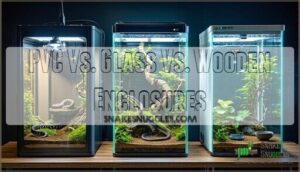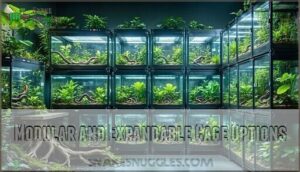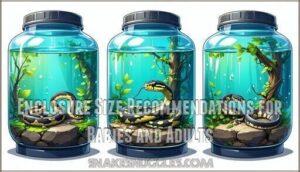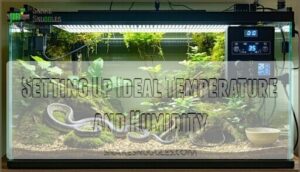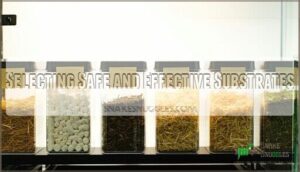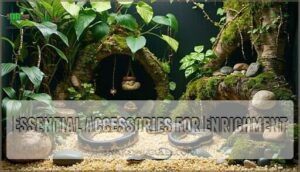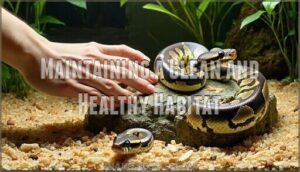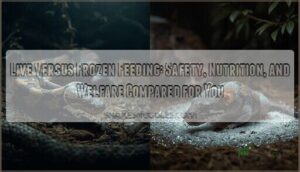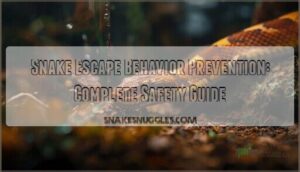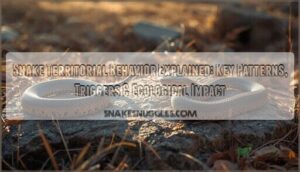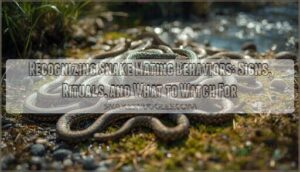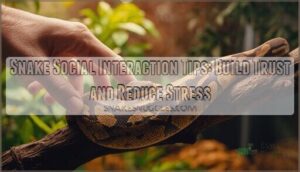This site is supported by our readers. We may earn a commission, at no cost to you, if you purchase through links.
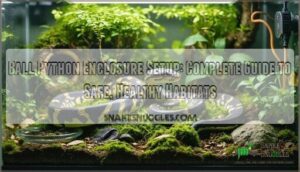
Whether you’re staring down racks of glass terrariums or puzzling over substrate options, the stakes are higher than they seem: the right enclosure means a snake that thrives, sheds well, and shows off those signature lazy coils. Ready to build a setup where your ball python feels right at home? The journey starts with a few key decisions—and some inside knowledge.
Table Of Contents
- Key Takeaways
- Choosing The Right Ball Python Enclosure
- Setting Up Ideal Temperature and Humidity
- Selecting Safe and Effective Substrates
- Essential Accessories for Enrichment
- Maintaining a Clean and Healthy Habitat
- Frequently Asked Questions (FAQs)
- Who makes a Python enclosure?
- How do I set up a ball python enclosure?
- Why should you choose a ball python enclosure?
- How big should a ball python enclosure be?
- What is the best snake enclosure for a ball python?
- How hot should a ball python enclosure be?
- What size enclosure does a ball python need?
- What is the best enclosure for ball pythons?
- Is a 75 gallon tank too big for a ball python?
- What do ball pythons need in their tank?
- Conclusion
Key Takeaways
- PVC enclosures outperform glass and wood by retaining heat more efficiently, maintaining stable humidity levels, and simplifying cleaning—making them the smartest long-term investment for ball python health.
- Your snake needs distinct temperature zones (87-92°F basking, 80-85°F warm side, 75-80°F cool side) and 60-70% humidity to properly digest food, shed cleanly, and avoid stress-related health problems.
- Enclosure size must match your python’s life stage—hatchlings thrive in 10-gallon setups while adults require at least 4 feet long by 2 feet wide to prevent stress and maintain healthy muscle tone.
- Moisture-retaining substrates like cypress mulch or coconut fiber paired with multiple hides, climbing branches, and daily spot-cleaning create the secure, enriching habitat that lets ball pythons exhibit natural behaviors and thrive.
Choosing The Right Ball Python Enclosure
Your ball python’s enclosure is the foundation of their health and happiness. The right cage makes all the difference in maintaining proper temperature, humidity, and security.
Let’s compare your main options so you can choose what works best for your snake and your budget.
PVC Vs. Glass Vs. Wooden Enclosures
When choosing between PVC enclosures, glass, and wood for your ball python’s home, you’ll want to weigh several practical factors. Here’s what matters most:
- Heat Retention: PVC and wood hold warmth better than glass tanks, reducing energy costs
- Humidity Control: PVC enclosures maintain ideal moisture levels more consistently than glass
- Cleaning Ease: PVC’s non-porous surfaces resist bacteria and wipe down quickly
- Cost Analysis: Reptile enclosures range from $289 to $889, with PVC offering long-term value
- Aesthetic Appeal: Glass provides visibility, while PVC balances function with clean design
PVC enclosures also offer superior heat retention, using up to 20% less energy than glass tanks. PVC generally wins for snake enclosure performance and maintenance simplicity.
Modular and Expandable Cage Options
Once you’ve picked the right material, you’ll need to think about whether your setup can grow with your snake. Modular and expandable enclosures offer smart space management for future expansion. Stackable enclosures and connecting habitats let you adapt as your ball python matures.
These adaptable systems provide enclosure customization options without replacing your entire setup. Reptile enclosure expansion becomes straightforward when you choose customization-friendly designs from the start.
Enclosure Size Recommendations for Babies and Adults
Your ball python’s home needs to match its size at every life stage. Hatchlings up to 300 grams do well in a 10-gallon enclosure (roughly 20" x 11" x 13"). Juveniles under 3 feet need at least 36" x 18" x 18", while adults over 3 feet require a minimum 48" x 24" x 24" setup—that’s 8 square feet of floor space.
To thrive, ball pythons also need proper temperature gradients within their enclosure. Sizing up as your snake grows prevents stress and keeps muscle tone strong.
Cost Comparison and Value Considerations
Before you hit checkout on that shiny new enclosure, let’s talk about what you’re actually paying for—and where you can save without cutting corners on your snake’s wellbeing. Ball python enclosure models range from $289 for starter cages to $889 for premium adult setups.
PVC offers better long-term savings through enhanced heat retention and enclosure lifespan, while glass tanks need extra equipment.
Budget for shipping costs and accessories upfront—quality enclosures hold resale value and prevent costly vet bills down the road.
Setting Up Ideal Temperature and Humidity
Getting the temperature and humidity right isn’t just about comfort—it’s the foundation of your ball python’s health. These snakes need specific warmth zones and moisture levels to digest food, shed properly, and stay stress-free.
Let’s break down how to create the perfect climate in your enclosure.
Creating a Temperature Gradient
Think of a ball python enclosure like a miniature climate zone—your snake journeys between warm and cool ends to self-regulate. Consistent gradient monitoring, paired with thermostat calibration, keeps temperature levels in check.
Use overhead heating to create a stable temperature gradient. Remember, even seasonal adjustments matter for a thriving python. It’s all about giving them control over their thermal regulation.
Basking Spot and Nighttime Temperature Control
When evening falls and daytime heat fades, your ball python still needs its own cozy hotspot for basking and a gentle drop in warmth to mimic night in the wild.
- Overhead Heat creates a reliable basking area.
- Use a thermostat for steady temperature.
- Basking Distance matters—avoid burns.
- Night Drops help simulate natural cycles.
- Infrared Lamps offer gentle nighttime warmth.
Maintaining Proper Humidity Levels
For your snake’s comfort and health, maintaining proper humidity is the quiet hero of reptile habitat humidity control. Aim for humidity levels between 60–70%—especially during shedding.
Mist the enclosure twice daily, adjust misting frequency as needed, and use humidity shields if the air is dry.
Measuring humidity helps prevent dehydration or shedding issues, giving your ball python its best shot at thriving.
Recommended Heating and Humidity Equipment
Every cozy reptile den starts with the right gadgets—so what gear makes it easy to keep your python’s home warm and just humid enough? Choose a heating system with a reliable thermostat for precise temperature levels and a thermal gradient.
Heating bulbs, accurate probe placement, humidity controllers, or misting systems all help maintain safe humidity levels. Explore your heating options; your snake will thank you.
Selecting Safe and Effective Substrates
Choosing the right bedding for your ball python makes all the difference in their comfort and health. With so many options out there, it can be tough to know what’s safe and effective.
Let’s look at what works best—and what to skip—regarding substrates.
Substrate Types: Cypress Mulch, Coconut Fiber, Aspen
Imagine your snake’s comfort is like a well-made bed—only better for burrowing! Cypress mulch holds substrate humidity just right and fosters natural digging, while coconut fiber offers excellent mold prevention and absorbs odors.
Aspen falls short for ball python enclosure setup, often drying out and skipping burrowing behavior. Mixing substrates, such as cypress mulch with coconut husk, balances safety and enrichment.
Avoiding Unsafe or Dusty Substrates
Nobody wants a cozy home full of sneezes—so let’s talk about which substrates can quietly sabotage your ball python’s health. Dusty or unsafe substrate options can cause big problems:
- Impaction risks from ingesting loose, abrasive materials
- Respiratory irritation from dusty products like fine sand
- Toxic chemicals or mold growth in non-reptile substrates
- Scratched scales or skin injuries from rough bedding
Choose wisely for a healthier habitat!
Bioactive Soil Vs. Traditional Options
Choose bioactive soil if you’re drawn to watching nature work its quiet magic—Ecosystem Establishment brings life to substrate for ball python cages, letting microfauna break down waste.
ReptiSoil or other mixes support burrowing and Behavioral Enrichment.
Traditional substrate options win on upfront cost, but bioactive beds reward patience with Humidity Stability and lower Long-Term Costs once established.
Substrate’s Role in Humidity and Health
When your python’s bedding lines up with its natural needs, you get more than just a cozy burrow—you create the steady humidity and safer health that makes every day easier for both of you.
Moisture-retentive substrates like ReptiSoil help hold proper humidity levels for ball pythons, aid shedding, support burrowing behavior, and control impaction and pathogen growth better than dusty or dry substrate options.
Essential Accessories for Enrichment
Ball pythons thrive in spaces that offer both comfort and stimulation. The right accessories can make all the difference for their health and happiness.
Here’s what you’ll need to create a home that truly fits your snake.
Hides, Caves, and Burrowing Spaces
From cozy hideouts tucked under logs to deep burrows in their favorite corner, your ball python craves quiet spaces where they can unwind and feel secure. Thoughtful interior setup with secure hides offers true habitat enrichment—consider these essentials:
- Multiple hides for stress relief
- Proper burrowing depth
- Cave hides using safe, natural cave materials
- Strategic hide placement
- Clean, stable, escape-proof shelters
Branches and Elevated Surfaces for Climbing
Just like a comfy spot to hide away, a sturdy branch or two gives your ball python a fun place to stretch out and see the world from a new angle. Semiarboreal snakes cherish Vertical Enrichment—mix branches and a solid Climbing Shelf for Habitat Enrichment. Secure Attachment and diverse Surface Material matter for climbing safety and satisfaction.
| Climbing Benefits | Enrichment Variety |
|---|---|
| Stress Reduction | Branch Placement Tips |
| Muscle Strength | Smooth vs. Textured |
Water and Food Dishes: Sizing and Placement
Even the simplest details—like where you put your snake’s water bowl—can make a real difference in their comfort and health. Choose a sturdy dish material that won’t tip, and keep water quality high with daily refills. Place food and water bowls away from hides.
Regular cleaning frequency is essential for Ball Python care, especially in any thoughtful interior setup.
Mimicking Natural Habitat Features
Though your ball python may never see the wilds of Africa, you can bring a bit of their natural world right into their enclosure with a few simple touches. Naturalistic decor—like sturdy branches for climbing, deep substrate for burrowing, and themed enclosures—turns your reptile habitat into a true haven, promoting habitat enrichment and healthy ball python enclosure design within your interior setup.
Maintaining a Clean and Healthy Habitat
Keeping your ball python’s home clean and safe does more than just make it look nice—it keeps your snake healthy, too.
Let’s walk through the must-do tasks that help create a space where your python can thrive. Here’s what you need to focus on next.
Regular Cleaning and Disinfection Schedule
Keeping your ball python’s enclosure sparkling clean isn’t just about looks—it’s one of the best ways to help your snake stay healthy and stress-free. Schedule a thorough disinfection every two to four weeks, using safe disinfectant choices.
Clean all surfaces, refresh the water bowl, and monitor waste buildup. Proper cleaning reduces pathogens and helps maintain ideal humidity and temperature levels essential for snake care.
Spot-Cleaning and Substrate Replacement
You know that feeling when your room goes from messy to fresh in a few minutes? A quick spot-clean and a fresh layer of substrate can work the same magic for your snake’s home.
Removing waste daily controls humidity levels and mold. Using safe disinfecting agents boosts snake care, while proper substrate depth and regular cleaning frequency depend on enclosure size and humidity control needs.
Monitoring for Stress and Health Issues
Ever notice your ball python acting more like an escape artist or refusing to eat for weeks? Subtle signals can reveal big issues in Ball Python Health and Wellbeing, from Stress Indicators and Shedding Problems to early signs of Respiratory Infections. Pay attention to:
- Abnormal hiding or frequent pacing
- Auditory wheezing or mouth gaping
- Sudden neurological signs or sluggishness
Ventilation, Safety, and Escape Prevention
A ball python can squeeze through a crack the width of your thumb, so a secure lid and proper airflow aren’t just nice—they’re your best insurance against a disappearing act.
Choose locking mechanisms or a locking dowel system, keep cords tucked safely, and opt for a screen top or smart airflow design. Childproofing cages prevents mishaps, ensuring real safe reptile housing.
Frequently Asked Questions (FAQs)
Who makes a Python enclosure?
Cage manufacturers such as Vision Cage and Zen Habitats lead the field in custom enclosures for reptiles. Reputable brands stand out for material quality, though many enthusiasts explore DIY enclosures when building a unique ball python enclosure or snake cage.
How do I set up a ball python enclosure?
Setting up a ball python enclosure means you’re building a micro-ecosystem—not just a cage. Start by choosing the right enclosure size, then add substrate, hides on both warm and cool sides, a water dish, and climbing branches.
Establish a temperature gradient and maintain proper humidity before introducing your snake.
Why should you choose a ball python enclosure?
Proper reptile enclosure features directly support animal welfare by enabling natural behaviors, reducing stress, and creating a healthier environment.
Choosing a snake enclosure that prevents escapes and promotes better physical health sets your ball python up for long-term success.
How big should a ball python enclosure be?
Most adults thrive in enclosures measuring at least 4 feet long by 2 feet wide. Babies can start smaller—around 3 feet—but they’ll outgrow it quickly, so planning ahead saves money and stress.
What is the best snake enclosure for a ball python?
PVC and wood beat glass every time—they trap heat better, lock in humidity, and wipe clean fast.
For adults, go 4-foot long minimum. Babies start smaller but upgrade quickly as they grow.
How hot should a ball python enclosure be?
Temperature matters more than you might think for your snake’s health. Your ball python needs three zones: a warm side (80-85°F), a cool side (75-80°F), and a basking area (87-92°F). Drop nighttime temperatures to 70°F.
This thermal gradient lets your snake regulate its body temperature naturally, preventing stress and digestive issues. Always monitor heat carefully to avoid burns.
What size enclosure does a ball python need?
Unlike Goldilocks searching for the perfect bed, your snake won’t settle for "just right"—you’ll need to plan ahead.
Babies thrive in smaller spaces like a Model 211 Cage, while adults need at least 36" x 18" x 18" enclosures, with 48" x 24" dimensions ideal for long-term planning and vertical space needs.
What is the best enclosure for ball pythons?
PVC enclosures are the preferred choice for Ball Pythons because they retain heat and humidity control better than glass. They’re easier to clean, hold stable conditions, and come in proper ball python enclosure sizes for babies and adults.
Is a 75 gallon tank too big for a ball python?
No, but it’s not ideal for most ball pythons. Large enclosures can trigger stress in younger snakes, making them feel exposed and vulnerable. Adults adapt better, though feeding in large spaces may require relocation.
Monitor ball python behavior closely to make certain they’re comfortable and thriving.
What do ball pythons need in their tank?
Your ball python needs hides on both warm and cool sides, a sturdy water dish for soaking, climbing branches, and a humidity-retaining substrate like cypress mulch.
These accessories support thermoregulation importance, hydration needs, and essential enrichment while preventing obesity through proper reptile habitat design.
Conclusion
Think of your ball python enclosure as a living blueprint—every element, from substrate to temperature gradient, works together to echo the safety of a termite mound or forest floor. When you dial in the details—proper hides, stable humidity, and thoughtful enrichment—you’re not just arranging decor. You’re building trust.
A well-designed ball python enclosure doesn’t just house a snake; it lets one thrive, shed cleanly, and settle into those signature, contented coils that tell you you’ve done it right.
- https://www.visionproducts.us/solutions/ball-python-enclosures/
- https://ball-pythons.net/forums/showthread.php?249310-A-note-on-ball-python-cage-sizes-lessons-from-Germany
- https://www.petmd.com/reptile/ball-python-care-sheet
- https://reptifiles.com/ball-python-care-guide/ball-python-humidity-temperatures/
- https://www.reddit.com/r/ballpython/comments/mkp12o/megathread_substrate/

